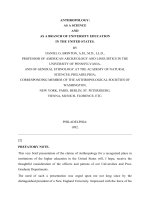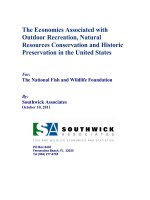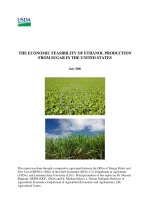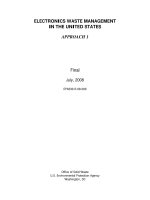Oil Shale Development in the United States potx
Bạn đang xem bản rút gọn của tài liệu. Xem và tải ngay bản đầy đủ của tài liệu tại đây (403.66 KB, 90 trang )
This document and trademark(s) contained herein are protected by law as indicated in a
notice appearing later in this work. This electronic representation of RAND intellectual
property is provided for non-commercial use only. Permission is required from RAND
to reproduce, or reuse in another form, any of our research documents.
Limited Electronic Distribution Rights
Visit RAND at www.rand.org
Explore RAND Infrastructure, Safety,
and Environment
View document details
For More Information
Purchase this document
Browse Books & Publications
Make a charitable contribution
Support RAND
This PDF document was made available from www.rand.org as
a public service of the RAND Corporation.
6
Jump down to document
The RAND Corporation is a nonprofit research
organization providing objective analysis and
effective solutions that address the challenges facing
the public and private sectors around the world.
THE ARTS
CHILD POLICY
CIVIL JUSTICE
EDUCATION
ENERGY AND ENVIRONMENT
HEALTH AND HEALTH CARE
INTERNATIONAL AFFAIRS
NATIONAL SECURITY
POPULATION AND AGING
PUBLIC SAFETY
SCIENCE AND TECHNOLOGY
SUBSTANCE ABUSE
TERRORISM AND
HOMELAND SECURITY
TRANSPORTATION AND
INFRASTRUCTURE
WORKFORCE AND WORKPLACE
INFRASTRUCTURE, SAFETY,
AND ENVIRONMENT
This product is part of the RAND Corporation monograph series. RAND
monographs present major research findings that address the challenges facing
the public and private sectors. All RAND monographs undergo rigorous peer
review to ensure high standards for research quality and objectivity.
James T. Bartis, Tom LaTourrette, Lloyd Dixon,
D.J. Peterson, Gary Cecchine
Oil Shale Development
in the United States
Prospects and Policy Issues
Prepared for the National Energy Technology Laboratory of the
U.S. Department of Energy
The RAND Corporation is a nonprofit research organization providing
objective analysis and effective solutions that address the challenges
facing the public and private sectors around the world. R AND’s
publications do not necessarily reflect the opinions of its research clients
and sponsors.
R
®
is a registered trademark.
© Copyright 2005 RAND Corporation
All rights reserved. No part of this book may be reproduced in any
form by any electronic or mechanical means (including photocopying,
recording, or information storage and retrieval) without permission in
writing from RAND.
Published 2005 by the RAND Corporation
1776 Main Street, P.O. Box 2138, Santa Monica, CA 90407-2138
1200 South Hayes Street, Arlington, VA 22202-5050
201 North Craig Street, Suite 202, Pittsburgh, PA 15213-1516
RAND URL: />To order RAND documents or to obtain additional information, contact
Distribution Services: Telephone: (310) 451-7002;
Fax: (310) 451-6915; Email:
Cover photo: A view east, down Ryan Gulch, towards the center of Piceance Basin.
Photographer: Linda Jones, Bureau of Land Management, White River Field Office
The research described in this report was conducted within RAND
Infrastructure, Safety, and Environment (ISE), a division of the RAND
Corporation, for the National Energy Technology Laboratory of the
U.S. Department of Energy.
Library of Congress Cataloging-in-Publication Data
Oil shale development in the United States : prospects and policy issues / James T. Bartis
[et al.].
p. cm.
“MG-414.”
Includes bibliographical references.
ISBN 0-8330-3848-6 (pbk. : alk. paper)
1. Oil-shales—United States. 2. Oil-shale industry—United States.
I. Bartis, James T.
TN859.U5O35 2005
622'.3383'0973—dc22
2005022573
iii
Preface
Since the early 1980s, oil shale has not been on the U.S. energy policy agenda, and
very little attention has been directed at technology or energy market developments
that might change the commercial prospects for oil shale. This report presents an
updated assessment of the viability of developing oil shale resources in the United
States and related policy issues. The report describes the oil shale resources in the
western United States; the suitability, cost, and performance of available technologies
for developing the richest of those resources; and the key energy, environmental,
land-use, and socioeconomic policy issues that need to be addressed by government
decisionmakers in the near future.
This work was performed at the request of the National Energy Technology
Laboratory of the U.S. Department of Energy. As this report was being prepared for
publication, the Energy Policy Act of 2005 became law. Although we were unable to
include the particulars of the Act in our analysis, this report is consistent with the
Act’s oil shale provisions and should be especially useful to federal officials responsi-
ble for implementing those provisions. This report should also be of interest to state,
tribal, and local government decisionmakers responsible for policy development and
implementation of the Energy Policy Act in the areas of energy resources, land man-
agement, and environmental protection. Technology developers, research managers,
and planning organizations should find the report useful in framing information
needs for future decisionmaking regarding oil shale development.
This report builds on earlier RAND Corporation studies on natural resources
development in the United States. Examples of this previous work include:
• Constraints on the Commercialization of Oil Shale, R-2293-DOE (1978)
• Understanding Cost Growth and Performance Shortfalls in Pioneer Process Plants,
R-2569-DOE (1981)
• Oil Shale in the Piceance Basin: An Analysis of Land Use Issues, R-3040-RC
(1983)
• New Forces at Work in Mining: Industry Views of Critical Technologies, MR-
1324-OSTP (2001)
iv Oil Shale Development in the United States: Prospects and Policy Issues
• Assessing Natural Gas and Oil Resources: An Example of A New Approach in the
Greater Green River Basin, MR-1683-WFHF (2003).
This research was conducted within RAND Infrastructure, Safety, and Envi-
ronment (ISE), a division of the RAND Corporation. The mission of ISE is to
improve the development, operation, use, and protection of society’s essential built
and natural assets and to enhance the related social assets of safety and security of
individuals in transit and in their workplaces and communities. The ISE research
portfolio encompasses research and analysis on a broad range of policy areas, includ-
ing homeland security, criminal justice, public safety, occupational safety, the envi-
ronment, energy, natural resources, climate, agriculture, economic development,
transportation, information and telecommunications technologies, space exploration,
and other aspects of science and technology policy.
Inquiries regarding RAND Infrastructure, Safety, and Environment may be
directed to:
Debra Knopman, Vice President and Director
1200 S. Hayes Street
Arlington, VA 22202-5050
Tel: 703.413.1100, ext. 5667
Email:
/>v
Contents
Preface iii
Figures and Table
vii
Summary
ix
Acknowledgments
xvii
Abbreviations
xix
CHAPTER ONE
Introduction 1
About This Study
2
Contents of This Report
3
CHAPTER TWO
The U.S. Oil Shale Resource Base 5
Oil Shale Resources in Place
5
The Green River Formation
5
Other Oil Shale Deposits in the United States
8
Recoverable Resources in the Green River Formation
8
Resource Ownership
9
CHAPTER THREE
Oil Shale Technologies 11
Mining and Surface Retorting
11
Mining Oil Shale
12
Surface Retorting
13
Technical Viability and Commercial Readiness
14
Costs
15
In-Situ Retorting
17
Thermally Conductive In-Situ Conversion
17
Technical Viability and Commercial Readiness
18
Costs
20
vi Oil Shale Development in the United States: Prospects and Policy Issues
Timeline for Oil Shale Development 21
CHAPTER FOUR
The Strategic Significance of Oil Shale 25
Direct Benefits of Domestic Oil Shale Production
26
Economic Profits
26
Employment Benefits
27
Reductions in the World Price of Oil
28
Enhanced National Security
30
Confounding or Inconclusive Arguments
31
Summary
32
CHAPTER FIVE
Critical Policy Issues for Oil Shale Development 35
Environmental and Social Impacts
35
Land Use and Ecological Impacts
35
Air Quality
38
Greenhouse Gas Emissions
40
Water Quality
40
Socioeconomic Impacts
42
Constraints to Strategically Significant Production
44
Production Costs
44
Market Risk
45
Leasing of Federal Lands
47
Water Consumption
50
CHAPTER SIX
The Development Path for Oil Shale 53
Business as Usual
54
Toward Industrial Development
55
Early Actions
55
A Measured Approach to Development
55
Public Participation
56
APPENDIX
Cost Estimation Methodology and Assumptions 59
Bibliography
63
vii
Figures and Table
Figures
2.1. Location of the Green River Formation Oil Shale and Its Main Basins 6
2.2. Stratigraphic Cross Section of the Piceance Basin in Colorado
7
3.1. Major Process Steps in Mining and Surface Retorting
11
3.2. The Shell In-Situ Conversion Process
18
3.3. Major Process Steps in Thermally Conductive In-Situ Conversion
19
3.4. Stages of Oil Shale Commercial Development
22
Table
A.1. Product Price Calculation Assumptions 60
ix
Summary
Since the early 1980s, oil shale has not been on the U.S. energy policy agenda, and
very little attention has been directed at technology or energy market developments
that might change the commercial prospects for oil shale. This report presents an
updated assessment of the viability of developing oil shale resources in the United
States and related policy issues. The report describes the oil shale resources in the
western United States; the suitability, cost, and performance of available technologies
for developing the richest of those resources; and the key energy, environmental,
land-use, and socioeconomic policy issues that need to be addressed by government
decisionmakers in the near future.
The U.S. Oil Shale Resource Base
The term oil shale generally refers to any sedimentary rock that contains solid bitu-
minous materials that are released as petroleum-like liquids when the rock is heated.
To obtain oil from oil shale, the shale must be heated and resultant liquid must be
captured. This process is called retorting, and the vessel in which retorting takes place
is known as a retort.
The largest known oil shale deposits in the world are in the Green River Forma-
tion, which covers portions of Colorado, Utah, and Wyoming. Estimates of the oil
resource in place within the Green River Formation range from 1.5 to 1.8 trillion
barrels. Not all resources in place are recoverable. For potentially recoverable oil shale
resources, we roughly derive an upper bound of 1.1 trillion barrels of oil and a lower
bound of about 500 billion barrels. For policy planning purposes, it is enough to
know that any amount in this range is very high. For example, the midpoint in our
estimate range, 800 billion barrels, is more than triple the proven oil reserves of Saudi
Arabia. Present U.S. demand for petroleum products is about 20 million barrels per
day. If oil shale could be used to meet a quarter of that demand, 800 billion barrels
of recoverable resources would last for more than 400 years.
x Oil Shale Development in the United States: Prospects and Policy Issues
Oil Shale Technology Prospects
Processes for producing shale oil generally fall into one of two groups: mining fol-
lowed by surface retorting and in-situ retorting.
Mining and Surface Retorting. Oil shale can be mined using one of two meth-
ods: underground mining using the room-and-pillar method or surface mining. The
current state of the art in mining—both room-and-pillar and surface techniques,
such as open pit mining—appears to be able to meet the requirements for the com-
mercial development of oil shale.
The current commercial readiness of surface retorting technology is more ques-
tionable. Development of surface retorts that took place during the 1970s and 1980s
produced mixed results. Technical viability has been demonstrated, but significant
scale-up problems were encountered in building and designing commercial plants.
Since then, major technical advances have occurred but have not been applied to sur-
face retorts. Incorporating such advances and developing a design base for full-scale
operations necessitates process testing at large but still subcommercial scales.
Cost information available from projects and design studies performed in the
1980s can be escalated to give a very rough estimate of the anticipated capital costs
for mining and surface retorting plants. Using this approach, a first-of-a-kind com-
mercial surface retorting complex (mine, retorting plant, upgrading plant, supporting
utilities, and spent shale reclamation) is unlikely to be profitable unless real crude oil
prices are at least $70 to $95 per barrel (2005 dollars).
In-Situ Retorting. In-situ retorting entails heating oil shale in place, extracting
the liquid from the ground, and transporting it to an upgrading or refining facility.
Because in-situ retorting does not involve mining or aboveground spent shale dis-
posal, it offers an alternative that does not permanently modify land surface topogra-
phy and that may be significantly less damaging to the environment.
Shell Oil Company has successfully conducted small-scale field tests of an in-
situ process based on slow underground heating via thermal conduction. Larger-scale
operations are required to establish technical viability, especially with regard to
avoiding adverse impacts on groundwater quality. Shell anticipates that, in contrast
to the cost estimates for mining and surface retorting, the petroleum products pro-
duced by their thermally conductive in-situ method will be competitive at crude oil
prices in the mid-$20s per barrel. The company is still developing the process, how-
ever, and cost estimates could easily increase as more information is obtained and
more detailed designs become available.
Development Timeline. Currently, no organization with the management,
technical, and financial wherewithal to develop oil shale resources has announced its
intent to build commercial-scale production facilities. A firm decision to commit
funds to such a venture is at least six years away because that is the minimum length
of time for scale-up and process confirmation work needed to obtain the technical
Summary xi
and environmental data required for the design and permitting of a first-of-a-kind
commercial operation. At least an additional six to eight years will be required to
permit, design, construct, shake down, and confirm performance of that initial com-
mercial operation. Consequently, at least 12 and possibly more years will elapse
before oil shale development will reach the production growth phase. Under high
growth assumptions, an oil shale production level of 1 million barrels per day is
probably more than 20 years in the future, and 3 million barrels per day is probably
more than 30 years into the future.
The Strategic Significance of Oil Shale
If the development of oil shale resources results in a domestic industry capable of
profitably producing a crude oil substitute, the United States would benefit from the
economic profits and jobs created by that industry. Additionally, oil shale production
will likely benefit consumers by reducing world oil prices, and that price reduction
will likely have some national security benefits for the United States. A hypothetical
shale oil production rate of 3 million barrels per day was assumed for the purpose of
calculating consumer benefits.
Economic Profits. If low-cost shale oil production methods can be achieved,
direct economic profits in the $20 billion per year range are possible for an oil shale
industry producing 3 million barrels per day. Through lease bonus payments, royal-
ties on production, and corporate income taxes, roughly half of these profits will
likely go to federal, state, and local governments and, thereby, broadly benefit the
public.
Employment Benefits. A manifestation of the economic benefits of shale oil
production is an increase in employment in regions where shale oil production
occurs or in regions that contain industries that provide inputs to the production
process. A few hundred thousand jobs will likely be associated, directly and indi-
rectly, with a 3 million barrel per day industry. The net effect on nationwide
employment is uncertain, however, because increases in employment arising from
shale oil production could be partially offset by reductions in employment in other
parts of the country.
Reduced World Oil Prices. Production of 3 million barrels of oil per day from oil
shale in the United States would likely cause oil prices to fall by 3 to 5 percent, but
considerable uncertainty surrounds any calculation on how large the effect might be,
especially when trying to model the behavior of the Organization of the Petroleum
Exporting Countries (OPEC) and other major suppliers far into the future. Assum-
ing a 3 to 5 percent fall in world oil prices, the resulting benefits to consumers and
business users in the United States would be roughly $15 billion to $20 billion per
year.
xii Oil Shale Development in the United States: Prospects and Policy Issues
National Security. A drop in world oil prices would reduce revenue to oil-
exporting countries. A 3 to 5 percent reduction in revenue would not change the
political dynamic in those countries a great deal. With regard to enhancing national
security, the principal value of oil shale production would be its contribution to a
portfolio of measures intended to increase oil supplies and reduce oil demand.
Other claims of the benefits of increased domestic oil production, such as a
reduced trade deficits and more reliable fuel supplies for national defense purposes,
are not well justified.
Critical Policy Issues for Oil Shale Development
The potential emergence of an oil shale industry in the western United States raises a
number of critical policy issues.
Land Use and Ecological Impacts. Of all the environmental impacts of oil shale
development, the most serious appears to be the extent to which land will be dis-
turbed. Regardless of the technical approach to oil shale development, a portion of
the land over the Green River Formation will need to be withdrawn from current
uses, and there could be permanent topographic changes and impacts on flora and
fauna. For surface retorting, extensive and permanent changes to surface topography
will result from mining and spent shale disposal. In-situ retorting appears to be much
less disruptive, but surface-based drilling and support operations will cause at least a
decade-long displacement of all other land uses and of preexisting flora and fauna at
each development site.
Air Quality. Oil shale operations will result in emissions that could impact
regional air quality. Studies in the 1970s and 1980s suggested that air emissions from
an industry producing a few hundred thousand barrels per day could probably be
controlled to meet then existing regulations. No studies have been reported since,
and no studies have considered output on the order of several million barrels per day.
Meanwhile, so much has changed in terms of environmental regulations, mining and
process technologies, and pollution control technologies that the earlier analyses are
no longer relevant.
Greenhouse Gas Emissions. The production of petroleum products derived
from oil shale will entail significantly higher emissions of carbon dioxide, compared
with conventional crude oil production. If these emissions are to be controlled, oil
shale production costs will increase.
Water Quality. All high-grade western oil shale resources lie in the Colorado
River drainage basin. For mining and surface retorting, the major water quality issue
is the leaching of salts and toxics from spent shale. A number of approaches are avail-
able for preventing surface water contamination from waste piles, but it is not clear
whether these methods represent a permanent solution that will be effective after the
Summary xiii
site is closed and abandoned. For in-situ retorting, inadequate information is avail-
able on the fate, once extraction operations cease, of salts and other minerals that are
commingled with oil shale.
Socioeconomic Impacts. Large-scale oil shale development will stimulate a sig-
nificant increase in the populations of northwestern Colorado and Uintah County in
Utah. Even a relatively small development effort, such as might occur during the
construction of a few initial commercial plants will result in a large population influx.
Rapid population growth will likely stretch the financial ability of local communities
to provide necessary public services and amenities.
Leasing. The richest and most abundant deposits of oil shale are found on fed-
eral lands managed by the U.S. Department of the Interior. As such, the course of oil
shale development and its environmental impacts will be shaped by federal decisions
regarding how much, when, and which specific lands will be offered for lease. At pre-
sent, the Department of the Interior does not have available a strategic approach for
leasing oil shale–bearing federal lands. The Energy Policy Act of 2005 has liberalized
the lease ownership provisions of the Minerals Leasing Act of 1920, thereby remov-
ing a major deterrent to private-sector investment in oil shale development. If mining
and surface retorting turn out to be the preferred approach to oil shale development,
the current lease size provisions of the Act will constrain resource recovery and
increase per-barrel mining costs and land disturbance.
Production Costs. Oil shale has not been exploited in the United States because
the energy industry, after some halting efforts, decided that developing oil shale was
economically unviable. Over the past two decades, very little research and develop-
ment effort has been directed at reducing the costs of surface retorting. For thermally
conductive in-situ retorting, costs might be competitive with crude oil priced at less
than $30 per barrel, but the technical viability of in-situ retorting will not be fully
established for at least six years.
Market Risks. As with many commodities, crude oil prices are highly volatile.
To hedge against the possibility of downward price movements, investments in pro-
jects with high capital costs, such as oil shale development, tend to be deferred until a
sufficient safety cushion builds up between anticipated production costs and what the
market is willing to pay. An added degree of uncertainty is associated with the poten-
tial response of OPEC nations to various market and technical developments.
Water Consumption. About three barrels of water are needed per barrel of shale
oil produced. Water availability analyses for oil shale development were conducted in
the early 1980s. These analyses indicated that the earliest constraining factors would
be limitations in local water supply systems, such as reservoirs, pipelines, and ground-
water development. A bigger issue is the impact of a strategic-scale oil shale industry
on the greater Colorado River Basin. Demands for water are expected to continue to
grow for the foreseeable future, making the earlier analyses regarding oil shale devel-
opment outdated.
xiv Oil Shale Development in the United States: Prospects and Policy Issues
Future Development Prospects
The prospects for oil shale development are uncertain. The estimated cost of surface
retorting remains high, well above the record-setting crude oil prices that occurred in
the first half of 2005. For surface retorting, it therefore seems inappropriate to con-
template near-term commercial efforts. Meanwhile, the technical groundwork may
be in place for a fundamental shift in oil shale economics. Advances in thermally
conductive in-situ conversion may cause shale-derived oil to be competitive with
crude oil at prices below $30 per barrel. If this becomes the case, oil shale develop-
ment could soon occupy a very prominent position in the national energy agenda.
We are rapidly approaching a critical juncture for oil shale development. On
June 9, 2005, the Bureau of Land Management released its Call for Nominations of
parcels to be leased for research, development, and demonstration of oil shale recov-
ery technologies in Colorado, Utah, and Wyoming. The response to this solicitation
will provide a clear signal about whether the private sector is prepared to commit its
resources to oil shale development. Government decisionmakers need to wait for that
signal. When it is clear that at least one major private firm is willing to devote, with-
out appreciable government subsidy, its technical, management, and financial
resources to oil shale development, government decisionmakers should address the
core policy issues listed above.
Key Recommendations
Business as Usual. The following are recommended whether or not oil shale is a
candidate for early efforts toward commercial production.
• Oil shale should be part of the Department of Energy’s research and develop-
ment portfolio. Significant long-term research opportunities are associated with
both surface retorting and in-situ retorting. A benefit of even a small federal
program (i.e., a few million dollars annually) would be the continued availabil-
ity of a small cadre of scientific and engineering professionals who would be
deeply knowledgeable of oil shale development issues.
• Consideration should be given to establishing a national oil shale archive that
would hold and preserve information on oil shale resources, technologies, and
impacts of development. We fear that, with the passage of time, important
information will be lost.
• Analysis should be directed at lease program implementation options, such as
combining adjacent lease tracts in a lease offering and provisions for ensuring or
promoting extensive recovery of resources within lease tracts.
Summary xv
In Support of Commercialization. Once clear indications are in hand that major
firms are ready to invest in scaling up and demonstrating oil shale technologies, gov-
ernment attention should be directed at gathering long lead time information
required to support future decisionmaking with regard to permitting and leasing.
Early action is appropriate for the following:
• Development and implementation of a research plan directed at establishing
options for mitigating damage to plants and wildlife and reducing uncertainties
associated with ecological restoration.
• Research directed at mathematical modeling of the subsurface environment,
combined with a multiyear hydrological, geochemical, and geophysical moni-
toring program. (This in the event that major industrial investments are
directed at in-situ retorting.)
• Research directed at establishing and analyzing options for long-term spent
shale disposal. (This in the event that major industrial investments are being
directed at mining and surface retorting.)
• Regional air quality modeling directed at determining preferred locations for
federal leasing and informing decisions on air quality permits for initial com-
mercial plants.
• Development of a federal oil shale leasing strategy for the Green River Forma-
tion, along with appropriate analytic and procedural approaches for timing and
selecting sites for lease offerings, establishing lease provisions, and avoiding
measures that will constrain future development.
Development at a Measured Pace. Many uncertainties regarding technology
performance and environmental and socioeconomic impacts remain unresolved.
While the above “early action” recommendations will serve to narrow uncertainties
and reduce the risks of making poor decisions, resolution of the most critical issues
associated with strategically significant levels of production will not occur until the
initial round of large-scale commercial facilities are constructed and operated—
a point that is at least 12 years down the road. A particularly pressing issue is the
viability of in-situ retorting because this approach may offer a more profitable and far
more environmentally benign alternative to mining and surface retorting. The pre-
vailing information shortfalls suggest that oil shale development should proceed at a
measured pace.
Public Participation. Because oil shale development could profoundly affect local
residents and other stakeholders, their inputs into federal decisionmaking need to be
sought and valued early in the process. The same holds true of the affected state gov-
ernments, tribal governments, and the wider citizenry, including nongovernmental
organizations representing citizens supportive of environmental protection, wildlife
conservation, and alternative land uses. An opportune time to broaden public
xvi Oil Shale Development in the United States: Prospects and Policy Issues
involvement is in conjunction with the preparations for a new round of federal leas-
ing of oil shale tracts. Toward this end, the federal government should consider fos-
tering the creation of a regionally based organization dedicated to planning, oversight
and advice, and public participation. Various venues are possible for this, including
the Western Governors’ Association and the Colorado and Utah state governments.
xvii
Acknowledgments
This study would not have been possible without the close collaboration that devel-
oped between the RAND authors and senior members of the research staff at the
Department of Energy’s National Energy Technology Laboratory (NETL). We are
especially grateful for the technical information and insights provided by Hugh D.
Guthrie, Lawrence J. Shadle, Robert W. Vagnetti, K. David Lyons, F. Dexter Sutter-
field, Thomas H. Mroz, and Maria C. Vargas. Our cost projections were based on a
discounted cash flow model developed by Mr. Vagnetti; both he and Dr. Shadle pro-
vided vital assistance as we searched the literature for useful cost and performance
information. We thank NETL management for fostering these very frank and open
discussions.
At the Bureau of Land Management in the Department of the Interior, Nick
Douglas helped us understand the bureau’s oil shale leasing program. We also thank
Sheri Thompson and Vern Rholl for photographs of some of the federal lands hold-
ing oil shale. From the Office of Fossil Energy in the U.S. Department of Energy,
Anton R. Dammer and Jeremy M. Cusimano shared with RAND their recently
completed work on oil shale development. With their cooperation, RAND was able
to send a representative to a DOE-sponsored Oil Shale Development Planning
Meeting held in Salt Lake City, Utah, on March 30 and 31, 2005.
At RAND, Keith Crane, Victoria Greenfield, and Michael Kennedy helped
frame the analyses presented in Chapter Four on the strategic significance of oil shale
development. Richard J. Hillestad helped us formulate our analytic approach.
This report benefited greatly from formal reviews conducted by Joel Darmstadt-
er, Brian M. Harney, and our RAND colleagues, Frank Camm and Debra Knop-
man.
xix
Abbreviations
BACT Best Available Control Technology
DOE Department of Energy
EIA Energy Information Administration
EIS Environmental Impact Statement
EM Employment multiplier
EPA Environmental Protection Agency
MLA Mineral Leasing Act
MACRS Modified Accelerated Cost Recovery System
NETL National Energy Technology Laboratory
OPEC Organization of the Petroleum Exporting Countries
OTA Office of Technology Assessment
PSD Prevention of Significant Deterioration
R&D Research and development
USC U.S. Code
USGS U.S. Geological Survey
1
CHAPTER ONE
Introduction
The United States contains massive amounts of oil held in mineral deposits known as
oil shale, located primarily in the states of Colorado, Utah, and Wyoming. The
recoverable energy from these high-grade deposits may be more than 800 billion bar-
rels of crude oil equivalent—more than triple the known oil reserves of Saudi Arabia.
For nearly a century, the oil shale in the western United States has been consid-
ered as a substitute source for conventional crude oil. But the economics of shale oil
production have persistently remained behind conventional oil. When crude oil
prices were about $3 per barrel in the 1960s and early 1970s, estimates of the
required selling price needed to make oil shale economic were about $6 per barrel. By
the late 1970s, world crude oil prices had increased to about $15 per barrel, but
estimates of the required selling price for oil shale had also sharply increased, ranging
from a low of $20 per barrel to a high of $26 per barrel (Merrow, 1978). Crude oil
prices jumped again in the winter of 1979–1980 in response to the Iranian crisis, and
so did estimates of the required selling price of shale oil, which were reported at more
than $45 per barrel in 1980 (OTA, Volume I, 1980).
1
Once again, the United States is in a period during which crude oil prices have
risen sharply. As in the past, concerns are being raised regarding the ability of world
oil supplies to meet growing demands, especially from the developing economies of
Asia. Once again, oil shale is being examined as a possible solution. In 2003, the
Bureau of Land Management in the U.S. Department of the Interior established an
Oil Shale Task Force to assess opportunities and prospects for oil shale development
on federal lands. In early 2004, the Office of the Deputy Assistant Secretary for
Petroleum Reserves, U.S. Department of Energy, released a report (Johnson, Craw-
ford, and Bunger, Volume I, 2004) asserting
Oil shale development holds the promise of assuring the Nation’s secure access to
strategically important fuels to drive the economy, meet national defense needs,
and fulfill global commitments.
____________
1
In this paragraph, all prices are in nominal—i.e., then-year—dollars.
2 Oil Shale Development in the United States: Prospects and Policy Issues
Most recently, and perhaps most significantly, the Bureau of Land Management
announced (Federal Register, 2005) that the bureau has concluded that “initiating
steps to help facilitate oil shale research and development (R&D) efforts is worth-
while” and that it was soliciting nominations of small parcels to be leased for oil shale
technology research, development, and demonstration projects in Colorado, Utah,
and Wyoming (U.S. Department of the Interior, 2005).
These developments raise the question of whether oil shale has now become a
technically and economically viable energy alternative to conventional sources of
crude oil. The recent increases in world oil prices, the potential leasing of federal oil
shale lands for research, and certain lately achieved technology developments present
a rich opportunity to consider issues and options for taking a strategic approach to oil
shale development, to ensure, among other goals, that economically, technologically,
and environmentally sound approaches to resource development are pursued.
About This Study
To answer this question, the RAND Corporation examined the opportunities and
challenges associated with developing oil shale resources on a strategically significant
scale in the United States. By “strategically significant,” we mean production of a few
million barrels per day—a level sufficient to have a marked impact on energy prices
and the world energy trade.
The purpose of the study was to evaluate the technological and economic
viability of oil shale development and to identify those issues, such as environmental
protection, resource access, and infrastructure constraints, that are critical to any suc-
cessful development effort. In addition, the study sponsor, the National Energy
Technology Laboratory (NETL), wanted to obtain an independent perspective as it
prepared a report requested by Congress on the viability of developing oil shale
reserves (U.S. House of Representatives, 2004).
To give due consideration to the broad range of technology, economic, and
policy issues associated with oil shale development, RAND assembled a multidisci-
plinary research team with expertise and experience in policy analysis, engineering
and the physical sciences, the life sciences, environmental analysis, and economics.
The RAND team conducted a thorough review of the extant scientific and policy
literature, conducted discussions with industry representatives and other stake-
holders, and held meetings and consultations with Department of Energy and
Bureau of Land Management scientists and engineers knowledgeable about oil shale
processing technologies and mining methods. The RAND researchers also were pro-
vided access to an internal NETL review of the costs and performance of alternative
approaches for mining and processing oil shale.
Introduction 3
Most of the information relevant to oil shale development was generated 20–30
years ago. While of great value in a number of aspects, many of the engineering
studies and environmental impact analyses are out of date. For some topics, such as
the management of federal oil shale lands, the early analyses are incomplete. There-
fore, to a large extent, this study can be viewed as a survey of the uncertainties associ-
ated with developing oil shale. To clear the path to development, some uncertainties
need to be resolved so that the appropriate decisions can be made. In other cases, we
note that resolution of uncertainties is not pertinent or should be postponed until the
private sector announces its intent to move forward with a specific technology
approach.
Contents of This Report
Chapter Two reviews the oil shale resource base. A key question we are concerned
with is whether the resource base is sufficient in size and character to support a
multimillion barrel per day industry.
Technology readiness and production costs will determine when an oil shale
industry will emerge. Chapter Three examines the status of known approaches for
producing fuels from oil shale, presents cost estimates, and reviews performance
issues. The chapter contains a timeline for technology R&D, demonstration, and
initial commercial operations required to bring fuels output from oil shale to a level
equivalent to several million barrels per day of crude oil equivalent.
Chapter Four explores the strategic significance for the United States of devel-
oping a domestic oil shale industry. It examines the special benefits that accrue from
putting additional oil into the marketplace.
The course of oil shale development is fraught with uncertainties for the private
sector, community stakeholders, and policymakers. Chapter Five identifies a number
of the most critical uncertainties surrounding the prospect of oil shale development.
The issues center on environmental protection, regional socioeconomic development,
infrastructure, leasing, and technology costs and performance. The chapter puts forth
a number of policy recommendations for addressing these concerns in parallel with
technology research and development.
Chapter Six steps back from specific issue areas and recasts our findings in terms
of the pathway to development and signals of industrial intent. Here, we also put
forth a few recommendations that cut across multiple issue areas.









